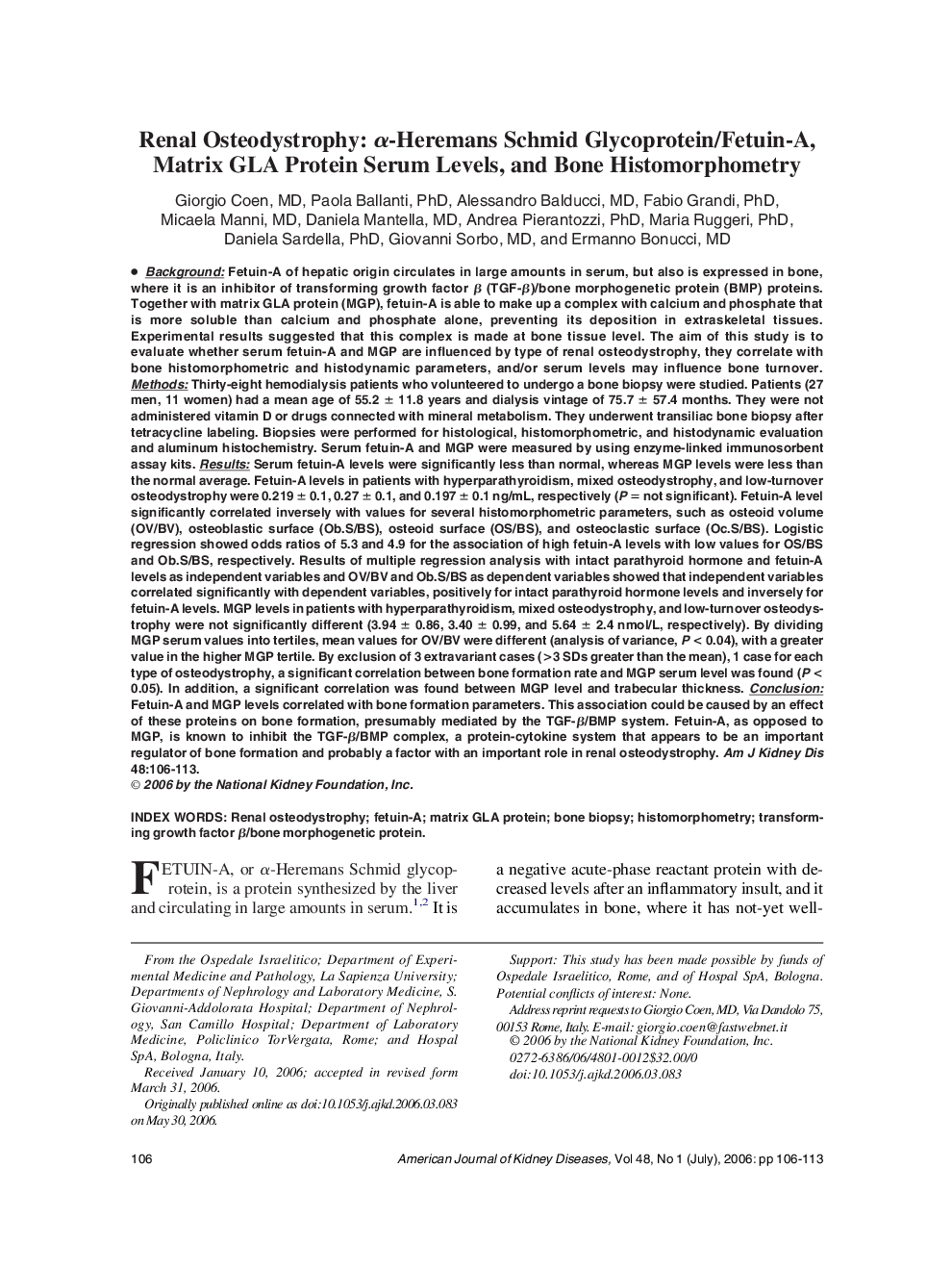| کد مقاله | کد نشریه | سال انتشار | مقاله انگلیسی | نسخه تمام متن |
|---|---|---|---|---|
| 3852686 | 1598384 | 2006 | 8 صفحه PDF | دانلود رایگان |
عنوان انگلیسی مقاله ISI
Renal Osteodystrophy: α-Heremans Schmid Glycoprotein/Fetuin-A, Matrix GLA Protein Serum Levels, and Bone Histomorphometry
دانلود مقاله + سفارش ترجمه
دانلود مقاله ISI انگلیسی
رایگان برای ایرانیان
کلمات کلیدی
موضوعات مرتبط
علوم پزشکی و سلامت
پزشکی و دندانپزشکی
بیماریهای کلیوی
پیش نمایش صفحه اول مقاله

چکیده انگلیسی
Background: Fetuin-A of hepatic origin circulates in large amounts in serum, but also is expressed in bone, where it is an inhibitor of transforming growth factor β (TGF-β)/bone morphogenetic protein (BMP) proteins. Together with matrix GLA protein (MGP), fetuin-A is able to make up a complex with calcium and phosphate that is more soluble than calcium and phosphate alone, preventing its deposition in extraskeletal tissues. Experimental results suggested that this complex is made at bone tissue level. The aim of this study is to evaluate whether serum fetuin-A and MGP are influenced by type of renal osteodystrophy, they correlate with bone histomorphometric and histodynamic parameters, and/or serum levels may influence bone turnover. Methods: Thirty-eight hemodialysis patients who volunteered to undergo a bone biopsy were studied. Patients (27 men, 11 women) had a mean age of 55.2 ± 11.8 years and dialysis vintage of 75.7 ± 57.4 months. They were not administered vitamin D or drugs connected with mineral metabolism. They underwent transiliac bone biopsy after tetracycline labeling. Biopsies were performed for histological, histomorphometric, and histodynamic evaluation and aluminum histochemistry. Serum fetuin-A and MGP were measured by using enzyme-linked immunosorbent assay kits. Results: Serum fetuin-A levels were significantly less than normal, whereas MGP levels were less than the normal average. Fetuin-A levels in patients with hyperparathyroidism, mixed osteodystrophy, and low-turnover osteodystrophy were 0.219 ± 0.1, 0.27 ± 0.1, and 0.197 ± 0.1 ng/mL, respectively (P = not significant). Fetuin-A level significantly correlated inversely with values for several histomorphometric parameters, such as osteoid volume (OV/BV), osteoblastic surface (Ob.S/BS), osteoid surface (OS/BS), and osteoclastic surface (Oc.S/BS). Logistic regression showed odds ratios of 5.3 and 4.9 for the association of high fetuin-A levels with low values for OS/BS and Ob.S/BS, respectively. Results of multiple regression analysis with intact parathyroid hormone and fetuin-A levels as independent variables and OV/BV and Ob.S/BS as dependent variables showed that independent variables correlated significantly with dependent variables, positively for intact parathyroid hormone levels and inversely for fetuin-A levels. MGP levels in patients with hyperparathyroidism, mixed osteodystrophy, and low-turnover osteodystrophy were not significantly different (3.94 ± 0.86, 3.40 ± 0.99, and 5.64 ± 2.4 nmol/L, respectively). By dividing MGP serum values into tertiles, mean values for OV/BV were different (analysis of variance, P < 0.04), with a greater value in the higher MGP tertile. By exclusion of 3 extravariant cases (>3 SDs greater than the mean), 1 case for each type of osteodystrophy, a significant correlation between bone formation rate and MGP serum level was found (P < 0.05). In addition, a significant correlation was found between MGP level and trabecular thickness. Conclusion: Fetuin-A and MGP levels correlated with bone formation parameters. This association could be caused by an effect of these proteins on bone formation, presumably mediated by the TGF-β/BMP system. Fetuin-A, as opposed to MGP, is known to inhibit the TGF-β/BMP complex, a protein-cytokine system that appears to be an important regulator of bone formation and probably a factor with an important role in renal osteodystrophy.
ناشر
Database: Elsevier - ScienceDirect (ساینس دایرکت)
Journal: American Journal of Kidney Diseases - Volume 48, Issue 1, July 2006, Pages 106-113
Journal: American Journal of Kidney Diseases - Volume 48, Issue 1, July 2006, Pages 106-113
نویسندگان
Giorgio MD, Paola PhD, Alessandro MD, Fabio PhD, Micaela MD, Daniela MD, Andrea PhD, Maria PhD, Daniela PhD, Giovanni MD, Ermanno MD,